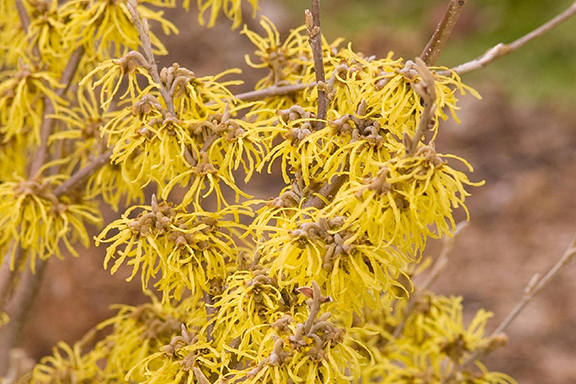Welcome!

There's nothing 'witchy' about witch hazel
Thinking of some interesting plants for fall, I happened upon an unusual shrub. I’ve never owned one myself, but I think it’s a must-have because of the fragrance of the blooms and the dazzling foliage. And what an interesting name: Witch Hazel!
This eye catching shrub is one of the toughest spreading shrubs and it thrives in woody areas and is virtually care free since it does not have any serious pest or disease issues.
Although some say the name comes from the fact that the blooms look like the withered fingers of a wicked old witch and has the spooky name because it blooms around Halloween, it actually got its name from the practice of Native Americans and early settlers who would use the branches to search for water sources, called dowsing or water-witching. There is nothing scary about this plant.
It is really a plant of health and happiness. Native Americans used witch hazel leaves and bark as a salve to reduce swelling and inflammation. They alo brewed the witch hazel leaves as a tea in order to treat colds, cuts, tumors and even eye irritation. Witch Hazel was taken internally to stop bleeding from hemorrhage.
The actual medial content (still used today) is hamamelis water, which is extracted by distilling the fresh and dried leaves as well as the bark. Tannins and volatile oils are the main active ingredients of Witch Hazel that contribute to its astringent benefits.
Used topically, Witch Hazel extract reduces inflammation and discomfort from abrasions, ingrown nails, cracked or blistered skin, insect bites, razor burn and poison ivy rash. A cold compress with Witch Hazel can help relieve headaches, heal bruises, post-partum swelling and hemorrhoids.
As a cosmetic, Witch Hazel is used as a facial astringent to reduce pore size, as a make-up remover, and to reduce eye puffiness.
So, if you want to grow your own Witch Hazel, you can start from scratch by ordering shrubs from the Arbor Day Foundation (Arborday.org). They normally ship between Nov. 15 and Dec. 2.
Start now so next Halloween you can have the witchy-est shrub around!
